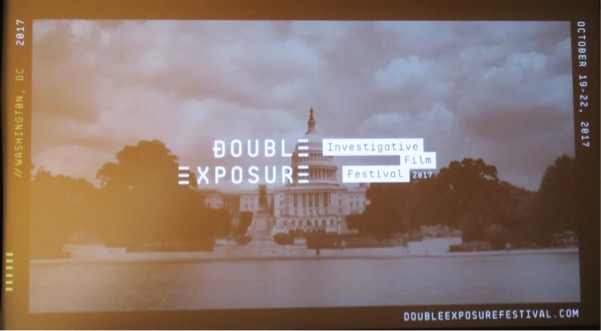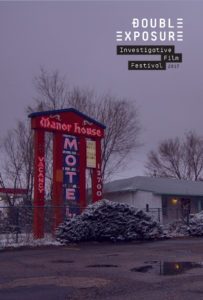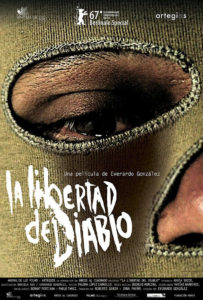Jay Berg’s 2017 Double Exposure (Investigative Film Festival) Coverage
Written by: Jay Berg | February 27th, 2018

The third annual Investigative Film Festival and Symposium (aka Double Exposure) saw a couple of significant changes from the previous two years. Instead of The National Portrait Gallery hosting all screenings during the festival, the venue was only involved in the Opening Night film, while all remaining films were screened at the Naval Heritage Center. Also, all symposiums were newly located at the National Union Building and The Loft instead of at The National Press Club. The good news is that all locations were still easily within walking distance once you made your way to the heart of downtown D.C.
The most significant change was expanding the festival from three to four days and fully incorporating the weekend (as I recommended in my review of the second annual festival). This expansion through Sunday allowed for even more documentary films (eleven up from eight in 2016) while providing a much user friendly weekend approach for the general public.
Returning once again were a full slate of symposiums that included one-on-one conversations, panels, workshops and mentoring sessions headed by scores of leading investigative journalists and filmmakers. Included were such diverse investigative topics such as Rapid Response in the Age of Trump, Protecting Sources and Subjects in a Newly Hostile Environment, Calculated Chaos: The Real Take on Fake news and Am Embedded: From Cinema Verité to Immersive Journalism.
Also, heading the festival for the third consecutive year were co-creators and co-directors Diana Jean Schemo and Sky Sitney. Diana, as the executive editor of the nonprofit news organization 100Reporters and Sky, who brings over twenty years experience in the media arts, both continued to bring unqualified leadership and expertise throughout the four day festival.
Their mission statement in this year’s catalog Welcome Letter succinctly stated their objective, noting that, “This year’s slate underscore the care, the determination and the risks investigative storytellers take, in print and film, to find and convey the closest approximation of truth they can reach. Fraught and messy as the process sometimes is, it is grounded in the belief that knowledge untethered to special interests is essential for democracy to function, and for a rich cultural life.”
Once again, Double Exposure clearly met these objectives as it continues to be one of the most unique and important filmic events in the country.
MY TOP 3 AT THIS YEAR’S DOUBLE EXPOSURE INVESTIGATIVE FILM FESTIVAL:

(1) Voyeur (**** out of 4 – 95 minutes)
With the recent explosive and disturbing revelations in the news concerning voyeuristic activities at vacation destinations, including the most recent at an Airbnb Florida location, this documentary couldn’t be more timely.
The D.C. premiere and closing night film was clearly the standout of the eleven films I screened. Directors Myles Kane and Josh Koury have crafted a superlative, albeit creepy, somewhat comedic documentary that, on the surface, appears to be strictly an exposé of a former Colorado 21-room roadside motel owner, Gerald Foos, who spied on his guests for decades. That fact alone would in and of itself hold ones attention. However, the filmmakers cleverly turn this singular sensational subject into one focused as much or more on legendary controversial journalist Gay Talese whom Foos entrusted his revelations decades before. Foos bought the hotel and custom fitted a hidden catwalk about the rooms where he stealthily and repeatedly spied on guests. Talese’s 1981 book on America’s sexual revolution, Thy Neighbor’s Wife (an eight year project which included his participation in the swinging sex scene-a revelation which nearly destroyed his career) spurs Foos to contact the author with his story. Intrigued, Talese met with him and discovered that Foos kept meticulous records documenting what he observed for those many years. He even joined him for one of his sessions where they were nearly caught above a copulating couple when the writer’s tie slipped through the ceiling vent cover during their voyeurism. At 84, the author, after following the story for over 30 years, wrote a short story in 2016 for The New Yorker that he expanded into a book, The Voyeur’s Motel. When a Washington Post reporter revealed certain inaccuracies, Talese was at first forced to publicly renounce his book but later retracted when minor inaccuracies could be readily explained while maintaining the overall accuracy of Foos’ nefarious activity. In the final analysis, the movie slyly asks whether Talese, or even the viewing audience are the true voyeurs of the title. The original Netflix documentary premiered on the network on December 1.

(2) No Stone Unturned (*** 1/2 out of 4 – 111 minutes)
The DC premiere of the latest film by the excellent prolific Academy Award-winning investigative documentarian Alex Gibney, focuses on an unsolved massacre in Loughinisland, Northern Ireland where, in 1994, six men were slaughtered and five others wounded by two masked men while they were watching a World Cup soccer match in a local pub. Despite a initial claim of responsibility by the Protestant paramilitary group called the Ulster Volunteer Force, the actual perpetrators were never charged and prosecuted – despite the immediate confiscation of key forensic evidence. Gibney opens the film recreating the shooting in lurid detail. From there, he gives a brief history of The Troubles, the ongoing conflict between Catholic republicans and Protestant loyalists that dated back to the 1920s. Determined to solve and eventually name the perpetrators, Gibney diligently documents his investigation – which ultimately reveals a possible massive political collusion and cover-up that appeared to reach from the local police up to the highest levels of the British government. The director obtained poignant interviews of surviving family members who are achingly longing for definitive answers beyond mere speculation. And Gibney’s anger is transparently obvious during interviews with key figures in the investigation as well as in his ongoing narrative. My main problem is his overdone continued use of the reenactments and the somewhat intrusive soundtrack by Ivor Guest. Although an essential question, as to whether the cover-up was maintained to avoid a flare-up in tensions between the two groups as the decades-long conflict appeared to be nearing an end, is never satisfactorily answered, the murder-mystery film never bores as key information, as well as the identity of the killers, are meticulously revealed. No Stone Unturned will likely have a limited U.S. theatrical release in 2018 followed by its later availability on Amazon.

(3) Devil’s Freedom (La Libertad Del Diablo) (*** 1/2 out of 4 – 74 minutes)
Director Everardo Gonzalez’s offers a fresh yet harrowing look at Mexico’s “disappeared” phenomenon where over 100,000 folks have been executed just over the last five years and have indirectly affected another 300,000 victims. Not all involve drug-related activities but also include roving gangs kidnapping, torturing, or murdering for non-payment of debts or merely to exert power over the defenseless citizenry. All of those interviewed (murderers, soldiers, and even orphaned toddlers) are masked and their anonymity allows each to freely and frankly relate their involvement without fear of retribution. The details related during the brief but effective 74 minutes are mind-boggling and much more effective in relating the horrors than can be gathered in a thousand cold news sound bites. Just a few examples of the everyday horror Mexican citizens face: a mother who recounts discovery of her son in a shallow grave by identifying his shoes; the man who infiltrated a cartel in search of his brothers; the young girl who recounts the moment her mother was kidnapped. And the killers who include one who recalls his indoctrination at the age of 14 when he was received an Audi as a reward for his first kill; or another who states payment for a kill could run as little as $10 or as much as $3000. Law enforcement officials are also depicted in some instances as corrupt as the gangs. Devil’s Freedom punctuates an illustration of a country that could be the most dangerous on earth. As of this writing, the film is still looking for domestic distribution.
BELOW ARE CAPSULE REVIEWS, IN ALPHABETICAL ORDER, OF THE REMAINING EIGHT FEATURES PRESENTED AT THE 4-DAY FESTIVAL:
Cocaine Prison (*** out of 4 – 78 minutes)
The prison is Bolivia’s notorious San Sebastian jail and it is here that director Violeta Ayala follows the blight of a drug mule arrested on his first cocaine run while his sister on the outside tries to win his freedom, and a father whose work in the coca fields has landed him inside the prison. Unlike Mexico, the drug trade in Bolivia is not run by violence but is sustained by ordinary folks whose lives are disposable and bleak. A powerful alternative look at the Bolivian drug trade and the deplorable conditions the condemned face who are unlucky to escape capture and prosecution. The film, which had its DC premiere at the festival, is currently in discussion for distribution.
Did You Wonder Who Fired The Gun? (** out of 4 – 70 minutes
The weakest of the films I screened is this somewhat experimental yet maddening doc by Travis Wilkerson who investigates the murder in 1946 of Bill Spann, an unarmed black man in rural Alabama by the director’s white supremacist great-grandfather. The director adds an unbelievably annoying narrative with bold visual texts which flash repeatedly over and over accompanied by an equally obnoxious soundtrack that had me constantly checking my watch. In the end, the 70 minute running time seemed like 140.
End Of Truth (*** out of 4 – 58 minutes)
The world premiere of this investigative film by Directors Eric Matthies and Tricia Todd covers the ISIS kidnappings during their rise to power in war torn Syria by focusing on the kidnappings of freelance journalist James Foley and photographer/correspondent John Cantile. The former was eventually beheaded after two years in captivity while the latter returns to the region despite having been captured once previously. The filmmakers obtained interviews with negotiators, investigators, and others caught up in the situation who desperately work to obtain their freedom. A powerful, emotional work that will stay with you long after its conclusion.
Hall Of Mirrors (**1/2 out of 4 – 87 minutes),
Fabled reporter/author Edward Jay Epstein is profiled by Ena Talakic and Ines Talakicthis in their DC Premiere of Hall of Mirrors. Now 81, the old school investigative journalist, who has authored 18 books, for the last 3 years has concentrated on Edwin Snowden who leaked classified documents pertaining to government surveillance in 2013. His old school methodologies are briefly explored in his past investigations such as the Warren Commission, the diamond industry, and the bizarre career of Armand Hammer. Also, a failed past attempt at film producing of The Iliad (with a script by Mario Puzo) is included in a scattered film that lacks focus but ultimately entertains. The doc is currently seeking distribution.
One Of Us (*** out of 4 – 95 minutes)
Academy-nominated directors Heidi Ewing and Rachel Grady (2006’s Jesus Camp) explores the world of New York’s Hasidic ultra-orthodox Judaism community as they follow the lives of three individuals over three years who have decided to leave the sect and enter the secular world. An abused divorce mother of seven, an abused teenager struggling with addiction and a would-be actor now living in LA who left the community eight years earlier each personalize their story and consider the cost they have endured while pursuing individual freedom. Their narratives are traumatic and haunting as each grapples with the decision to leave the only world they have ever known. I would have like a parallel look inside the Hasidic community that would have rounded out the discussion on both sides. (I suspect the elders would not have granted much access in this regard to the two directors.) However, the film succeeds by introducing a world that is both hidden and mysterious. One Of Us is currently available on Netflix.
The Other Side Of Everything (*** out of 4 – 100 minutes)
Winner of the Feature-Length Competition at Amsterdam’s IDFA, the world’s largest non-fiction festival, the U.S. premiere of the latest doc by director Mila Turajic is essentially a portrait of the director’s Serbian mother and the apartment in which she lived. Srbijanka was Serbia’s deputy education minister from 2001-2004 and a prominent revolutionary in the 1990s during the former Yugoslavia’s tumultuous period. Using the Communist divided apartment as a metaphor for the political upheaval and through the use of archival footage and interviews, Mila tries to personalize a complicated recent history of a region ruled first by Tito followed by Milosevic and the aftermath of his downfall. Distribution of the film has not yet been finalized as of this writing.
The Rape Of Recy Taylor (*** out of 4 – 91 minutes)
The D.C. premiere of this haunting film by director Nancy Buirski (2011’s The Loving Story) recounts the 1944 rape of a 24-year-old black mother in Alabama by six white boys as she walked home from church. Although most white on black rapes went unreported by African-American women during this time and place, Recy Taylor refused to recoil – even enlisting the chief investigator for the NAACP: Rosa Parks – years before her Montgomery bus boycott. Told through old photographs and movies, as well as interviews with Recy’s brother and sister (Recy, who turned 98 on New Years Eve was not lucid enough to be interviewed), the documentary mirrors a mindset of racism that, until then, was largely ignored by the mainstream media. The Rape Of Recy Taylor began a limited theatrical release last December 8.
TrustWHO (*** out of 4 – 85 minutes)
The Geneva-based World Health Organization is given the once-over in director Lilian Franck’s searing exposé which had its world premiere at the IFF. This United Nations body, with the responsibility of protecting global health, has been found to be an organization lacking funding, power and transparency and that has been invaded by special interests groups including the tobacco, pharmaceutical and nuclear industries. The end result is an organization fraught with special interests that is making governmental politics obsolete and is affecting their ability to focus on world health. No distribution deal has yet to be finalized as of this writing.
Jay Berg lives in Baltimore, MD. His blog “Jay Berg’s Cinema Diary” can be read at http://jayberg.blogspot.com/. He can be contacted at jaybergscinemadiary@gmail.com

